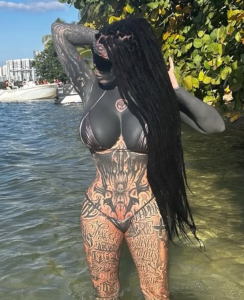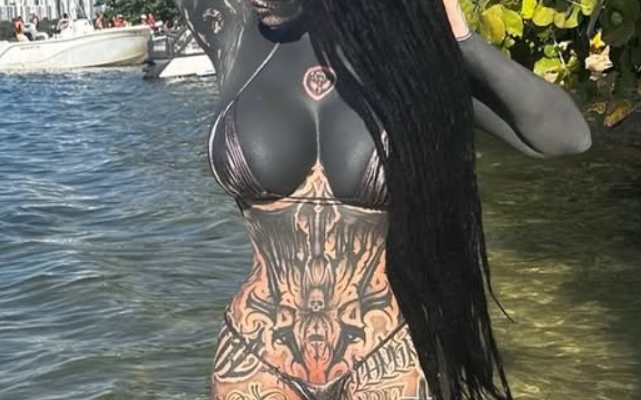Title: “The Jar on the Shelf”
You wouldn’t notice the jar at first. It’s small, unassuming, tucked between a ceramic skull and a dried bouquet of black roses. But once you see it—really see it—it’s impossible to look away. Inside, suspended in a clear solution, is a human nose. Her nose.
Toxii Daniëlle doesn’t flinch when people ask. “Yes,” she says, “it’s mine.” Her voice is calm, her gaze direct. She’s used to the questions, the stares, the whispers. Her body is a canvas of ink and transformation—blackout tattoos cover her arms and chest, her eyes are dyed pitch black, and her tongue splits like a serpent’s. Horn-like implants rise from her forehead, and her face, once soft and symmetrical, is now a sculpted rebellion against beauty standards.
But before all this—before the jar, the ink, the implants—she was someone else.
Six years ago, Toxii was Ana. Blonde hair, soft makeup, a face that fit neatly into society’s mold. She worked in retail, smiled politely, and spent her weekends scrolling through Instagram, envying the boldness of others. She felt like a ghost in her own skin—visible, but not seen. Her reflection was a stranger. Her body, a costume she never chose.
It started with a single tattoo. A small crescent moon behind her ear. Then came the piercings, the blackout sleeves, the eye tattoos. Each modification was a step away from Ana and a step toward Toxii. The nose was the final frontier.
“I wanted to be imperfect,” she told artist Devon Rodriguez in an interview. “Imperfections make you unique.”
The procedure was brutal. Eight weeks of healing, pain that clawed through her face, and the constant hum of judgment from strangers. But when she looked in the mirror, she saw herself—finally. Not Ana, not a product of expectation, but Toxii: raw, defiant, and whole.
She kept the nose. Not out of morbidity, but reverence. It sits in the jar like a relic, a symbol of rebirth. “I have all my body parts,” she says. “In little jars.”
Online, reactions are split. Some call her possessed, others hail her as a goddess of self-expression. “You were so beautiful before,” one commenter writes. “Why do you hate yourself?” another asks. But Toxii doesn’t hate herself. She hated the silence, the invisibility, the conformity. Now, she’s loud—even when she doesn’t speak.
Her Instagram is a gallery of transformation. Side-by-side photos show the stark contrast: Ana in 2019, smiling with untouched skin; Toxii in 2023, fierce and unapologetic. The difference is jarring. But beneath the ink and implants, the essence remains. She’s still the girl who craved authenticity, who wanted to be seen—not for her beauty, but for her truth.
Some say it’s too much. That she’s gone too far. That body modification should be gradual, thoughtful. But Toxii disagrees. “This quick impulsiveness breeds discontent and regret,” one critic wrote. But for her, it bred liberation.
She walks through Madrid like a living art piece. Children stare, adults avert their eyes, and tourists ask for selfies. She’s used to it. Her body is a manifesto, her face a protest. She doesn’t seek approval—only space to exist.
In private, she’s gentle. She reads poetry, collects vintage taxidermy, and listens to ambient music. Her apartment smells like sandalwood and ink. The jar sits on a shelf above her desk, next to a photo of Ana. Not as a warning, but a reminder: of where she came from, and who she chose to become.
She’s not trying to be a role model. She’s not campaigning for body modification rights or pushing others to follow her path. She’s simply living—on her own terms. And in a world that demands conformity, that’s revolutionary.
Her story isn’t just about tattoos or nose removal. It’s about identity, autonomy, and the courage to rewrite your narrative. It’s about choosing discomfort over invisibility, authenticity over acceptance.
Toxii Daniëlle is not for everyone. But she’s for herself. And that, in a world obsessed with fitting in, is the most radical act of all.


